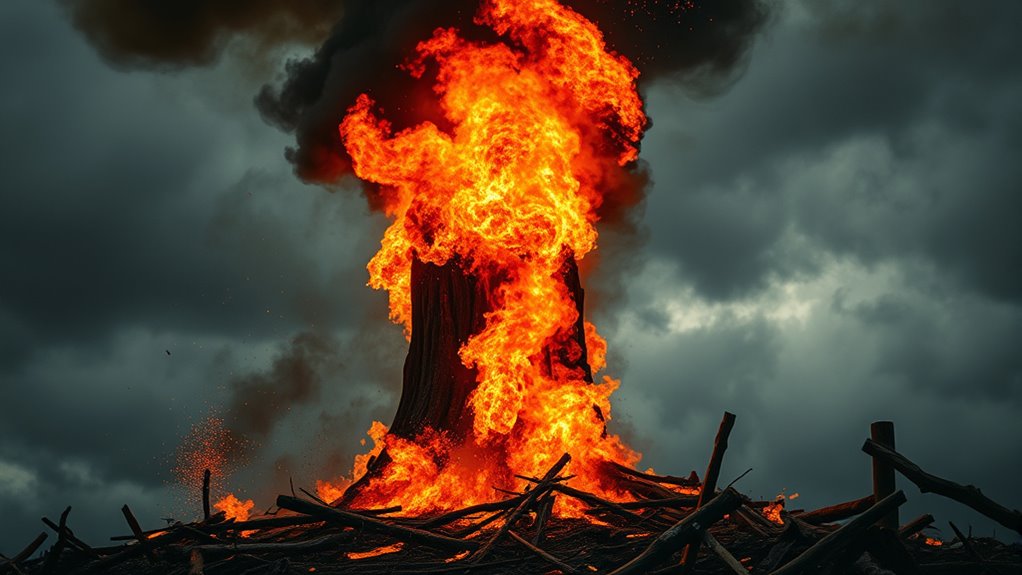When a public figure makes a mistake, social media quickly reacts, turning small missteps into a firestorm within minutes. Viral tweets, hashtags, and videos amplify outrage, while misinformation spreads fast. Influencers and users contribute to a cycle of accusations and defenses, often escalating the controversy. The urgency to respond intensifies pressure on those involved, shaping perceptions and damage. If you’re curious about how each rapid step unfolds, keep exploring the details behind these social media explosions.
Key Takeaways
- A misstep by a public figure quickly spreads via social media, triggering viral reactions and trending hashtags.
- Rapid dissemination fosters a sense of urgency, prompting swift public responses and often hasty apologies or defenses.
- Social media platforms amplify outrage, turning minor issues into moral battlegrounds with misinformation and mob mentality.
- The controversy intensifies minute-by-minute, with public perception shaped by online discourse and spectacle.
- The speed of the viral cycle can cause lasting damage or swift recovery, depending on the response and societal reaction.

In recent years, cancel culture has ignited a firestorm of controversy, forcing society to confront the limits of accountability and free speech. When a public figure or organization makes a misstep, the initial reaction often erupts on social media, where users rapidly mobilize to voice their outrage. You might see a tweet or video go viral almost instantly, sparking a wave of social media discourse that amplifies the issue. This online chatter creates a sense of immediacy, making it feel like the entire world is watching and judging. The public backlash builds quickly, with hashtags trending and comments flooding in from all directions. You can feel the intensity as supporters and critics clash, each side staking out their position. This rapid spread leaves little room for nuanced discussion, turning complex issues into black-and-white morality battles.
As the controversy gains momentum, it becomes clear that social media acts as both a megaphone and an echo chamber. The platform’s design encourages virality, so a single post or comment can escalate a situation from a minor offense to a full-blown cancelation. You might observe how influencers, journalists, and everyday users contribute, each adding their voice to the whirlwind. The discourse often devolves into shouting matches, with accusations flying and defenses dismissed. This environment makes it easy for misinformation, outrage, and mob mentality to flourish. Over a matter of hours or days, what started as a single misstep morphs into widespread calls for accountability, boycotts, or public apologies. Additionally, the speed of dissemination plays a crucial role in shaping the intensity and scope of these online phenomena.
The speed at which this unfolds fuels a sense of urgency, pressuring those involved to respond quickly. Public figures, companies, or organizations caught in the crossfire often scramble to manage their reputation, issuing apologies or clarifications. But sometimes, the damage is already done. The public backlash can be relentless, with social media discourse shaping perceptions and influencing future actions. You might notice how some cancellations stick, permanently damaging careers or brands, while others fade away as new topics emerge. This minute-by-minute breakdown shows how social media accelerates the process, turning individual errors into collective moral verdicts. It highlights how cancel culture is less about justice and more about the spectacle, with the crowd’s roar shaping what gets remembered—and what gets erased.
Frequently Asked Questions
How Do Social Media Algorithms Influence Cancel Culture Dynamics?
Social media algorithms play a big role in cancel culture dynamics by prioritizing viral content, which spreads quickly and amplifies outrage. You might not realize that algorithm bias can skew what gets seen, making certain voices louder while silencing others. This rapid dissemination fuels emotional reactions and collective outrage, often leading to canceling someone without fully understanding the context. So, your exposure heavily depends on what the algorithm promotes, shaping cancel culture’s momentum.
What Psychological Factors Drive Individuals to Participate in Cancel Campaigns?
Imagine you’re in the 18th century, burning effigies, feeling moral outrage. Today, you join cancel campaigns driven by psychological factors like groupthink conformity, where you follow the crowd to avoid social rejection. The desire to uphold shared morals, gain approval, or feel righteous fuels your participation. These factors create a cycle, making it easier to jump on the bandwagon and contribute to the firestorm, even if you’re unsure about the details.
How Do Different Communities Respond Uniquely to Cancel Culture Incidents?
You notice how different communities respond uniquely to cancel culture incidents because of cultural variability. Some communities show resilience, rallying together to support the accused, while others react with swift condemnation. Your understanding reveals that community resilience and cultural norms shape these responses, with some valuing forgiveness and dialogue, and others prioritizing accountability. Recognizing these differences helps you see cancel culture as a reflection of each community’s values and social dynamics.
What Are the Long-Term Impacts of Being Canceled on Personal Reputation?
Ironically, getting canceled might boost your media reputation temporarily, but the long-term impact isn’t so kind. You could face lasting damage to your personal reputation, making it harder to rebuild trust. Professional consequences often linger, affecting future opportunities. While some bounce back, many find their image permanently scarred, proving that what seems like a quick comeback can turn into a long, uphill battle for redemption.
Can Cancel Culture Ever Be Effectively Moderated or Controlled?
You wonder if cancel culture can be effectively moderated or controlled. While social accountability plays a crucial role in addressing harmful behavior, it’s challenging to set clear ethical boundaries that prevent overreach. By encouraging open dialogue and emphasizing proportional responses, communities can foster a more balanced approach. Ultimately, ongoing conversations about accountability and ethics are essential to prevent cancel culture from spiraling into unjust or excessive consequences.
Conclusion
As you navigate this cancel culture firestorm, remember it’s like the storm of the century—chaotic, quick, and relentless. You’re caught in a digital tempest where every tweet can spark a wildfire, much like the Great Fire of London, only now it’s fueled by outrage and memes. Stay vigilant, question motives, and don’t forget: even in a world of instant updates, patience and perspective are your best allies. The fire will burn out—eventually.










